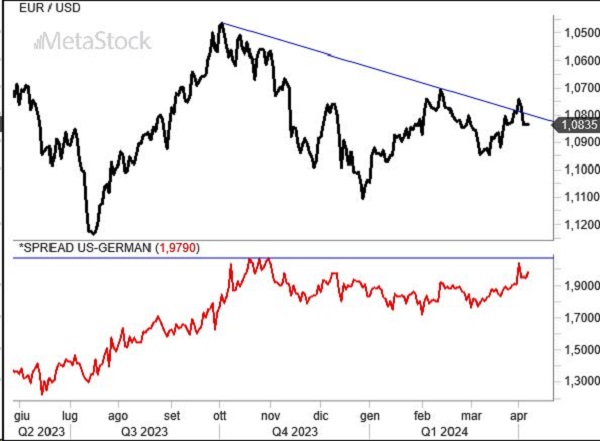- Powell cools off interest rate fervor, urging caution and a careful examination of upcoming data. The economy is galloping, as recent employment numbers and leading indicators have shown, with looming elections possibly advising a more cautious stance on rates.
- Inflation cools in the Eurozone, and a rate cut in Europe seems closer. Yet, the euro, despite everything, withstands the dollar’s attempts to push lower.
- EurUsd attempts to break key supports at 1.08 but fails. A sign that perhaps the dollar lacks the strength at this moment to push further, and the market does not believe in a Fed on hold for 2024.
Inflation and Economic Growth: The Tightrope Walk of Global Central Banks
Inflation data continues to act as a catalyst for future central bank maneuvers. However, American economic growth also presents a challenge for those hoping for an immediate easing approach from the Fed. Powell’s pre-Easter comments seemed hawkish after the March FOMC, but the Chairman likely had inside information on the upcoming ISM manufacturing report which last Monday surprised everyone by returning above the 50-point mark that separates expansion from economic slowdown. This data also saw a return to expansion territory for the sub-components of production and new orders, as well as a resurgence in the price component, moving from 52.5 to 55.8, the highest point since August 2022. Apparently, inflation has not been tamed.
Employment also remains robust with over 300,000 jobs created in March. The bond market reacted immediately, with ten-year Treasury yields well over 4.25%, and reduced likelihood of a rate cut in June according to the market. The spread between US and German government bonds has thus spiked, surpassing 200 basis points and fueling a new attempt to break through supports by EurUsd, yet without success.
European inflation in March positively surprised with CPI dropping from 2.6% to 2.4%. Among 20 member states, a quarter have an annual inflation rate below the 2.0% target, and more than half are below 3%. In nearby Switzerland, consumer prices have even slipped to 1%, hitting the Swiss franc hard and making it a favored carry trade currency for investors. However, this does not feed into expectations of interest rate cuts. Seven cuts were expected in the US at the start of the year, now there are just three, possibly two, not ruling out a no-event considering the upcoming election.
Technical Analysis: Yield Spreads and Dollar Strength Signals
The spread between US and German ten-year yields rose above 200 basis points for a few sessions, aiding the dollar, but the immediate reaction of the euro and the subsequent return of the spread effectively marked as a bear trap (here the chart is on an inverted scale) the attempt by the greenback to definitively break the 1.08 supports. In 2023, an equivalent spread corresponded to an exchange rate in the 1.06 zone. A potential sign of weakness in the dollar’s relative strength to take into account.

The Dollar Index clearly shows how important the recent levels reached by the dollar are. The 61.8% Fibonacci retracement of the decline that began in October 2023 was already able to curb the strength of the greenback in February. Now we’re here again with the post-Easter bearish candle potentially marking a double top with the test of the 105 area by the Dollar Index. A return to the 103 area is likely at this point.



Leave a Reply
You must be logged in to post a comment.